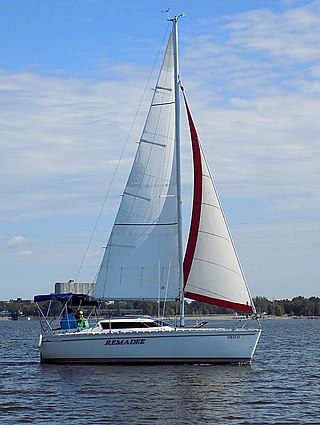Related Research Articles

The Nonsuch 22 is a Canadian trailerable sailboat, the smallest of the series of Nonsuch sailboats. It was designed by Mark Ellis Design and first built in 1984.

The Tonic 23 is a French trailerable sailboat, that was designed by Philippe Harlé as a coastal cruiser and first built in 1985.

The Marshall 22 is an American trailerable sailboat that was designed by Breckenridge Marshall as a cruiser and first built in 1965.
The Alerion Express 19 is an American trailerable sailboat that was designed by Gary Hoyt as a cruiser and first built in 1998.
The Bay Hen 21 is an American trailerable sailboat that was designed by Reuben Trane as a pocket cruiser and first built in 1984.
The Com-Pac Horizon Cat, also called the Horizon Cat 20, is an American trailerable sailboat that was designed by Halsey Herreshoff as cruiser and first built in 2002.
The Herreshoff America, also called the Herreshoff America 18, is an American trailerable sailboat that was designed by Halsey Chase Herreshoff as a cruiser and first built in 1971.
The Eolia 25 is a French trailerable sailboat that was designed by Philippe Briand as a coastal cruiser and first built in 1983.
The Menger Cat 17 is an American trailerable sailboat that was designed by Andrew Menger as a daysailer and cruiser and first built in 1983.
The Menger Cat 19, also sold as the Thom Cat 19 Catboat, is an American trailerable sailboat that was designed by father and son team Bill Menger and Andrew Menger as a daysailer and cruiser and first built in 1990.
The Menger Cat 23, also called the Thom Cat 23. is an American trailerable sailboat that was designed by Bill and Andrew Menger, based on the work of Francis Sweisguth. It was intended as daysailer and cruiser and first built in 1990.
The Montego 25 is an American trailerable sailboat that was designed by Johannes "Jopie" Helsen as a racer-cruiser and first built in 1980.
The Mystic Catboat 20 is an American trailerable sailboat that was designed by Peter Legnos as a cruiser and first built in 1974.
The O'Day 222 is an American trailerable sailboat that was designed by C. Raymond Hunt Associates as a cruiser and first built in 1984.
The Pearson 23 is an American trailerable sailboat that was designed by William Shaw as a cruiser and first built in 1978.
The Peep Hen 14 is an American trailerable sailboat that was designed by Reuben Trane as a cruiser and first built in 1981.
The Picnic 17 is an American trailerable boat that was designed by Nils Lucander as a sailboat/powerboat cruiser hybrid and first built in 1959.
The S2 7.0 is an American trailerable sailboat that was designed by Arthur Edmunds as a cruiser and first built in 1975. The designation indicates the approximate length overall in meters.
The Seaward 23 is an American trailerable sailboat that was designed by Nick Hake as a pocket cruiser and first built in 1984.
The Slipper 17 is an American trailerable sailboat that was designed by Nick Hake as a pocket cruiser and first built in 1981.
References
- 1 2 3 4 5 6 7 McArthur, Bruce (2020). "Sanderling sailboat". sailboatdata.com. Archived from the original on 27 July 2021. Retrieved 27 July 2021.
- 1 2 3 4 5 6 7 8 Henkel, Steve: The Sailor's Book of Small Cruising Sailboats, page 40. International Marine/McGraw-Hill, 2010. ISBN 978-0-07-163652-0
- ↑ Marshall Marine Corporation. "18' Sanderling". marshallcat.com. Archived from the original on 27 July 2021. Retrieved 27 July 2021.
- ↑ McArthur, Bruce (2021). "Marshall Marine Corp". sailboatdata.com. Archived from the original on 27 July 2021. Retrieved 27 July 2021.
- ↑ Rappaport, Stephen (6 June 2020). "Prowling the Coast in a Catboat". Maine Boats. Archived from the original on 27 July 2021. Retrieved 27 July 2021.
- ↑ "Boat Review: Marshall Sanderling". Small Craft Advisor. 12 November 2008. Archived from the original on 27 July 2021. Retrieved 27 July 2021.
- ↑ Nielsen, Peter; Cort, Adam (28 August 2019). "Trailerable Cruisers". Sail magazine. Archived from the original on 27 July 2021. Retrieved 27 July 2021.